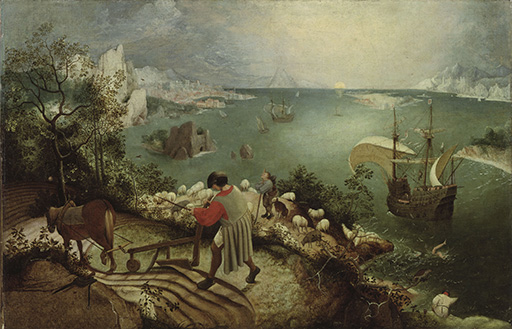4 Brueghel and Auden
This next section will explore how far Ovid’s own agenda (artistic, personal and, to some extent, ideological) has shaped two famous representations of Icarus in painting (Brueghel’s Landscape with the Fall of Icarus) and poetry (W.H. Auden’s Musée des Beaux Arts). These subsequent versions of the myth may on the surface depart from Ovid’s narrative, and you should note that the poem is actually reacting to the painting in the first instance, and is, therefore, ‘once removed’ from Ovid.
If you already have some skills of visual analysis or feel comfortable with literary critiques of twentieth-century poetry, then both the painting and the poem may prompt you to ask questions about their form and composition. If not, then you can follow the guidelines below; these will help you to analyse artistic and literary techniques in the retelling of the myth. In these separate boxes you will find a brief biography of Brueghel and Auden plus a few central characteristics (or ‘tools of the trade’) of their chosen genres which can be fruitfully applied to their texts.
Brueghel and his work
Pieter Brueghel the Elder was born around 1520 and died in 1569. He was master of the Antwerp Guild in 1552 and is renowned for his landscape painting (the Alps and Italian scenery inspired his work). But his subsequent reputation fluctuated with positive and negative reactions to a satiric and graphic style of representation, pictures of peasants, life in the raw, allusions to contemporary troubles and so on – he lived and worked in turbulent times with constant political and religious turmoil in the Netherlands.
What to look for in a painting
The subject matter is an obvious starting point and the title tells the viewer quite a lot. Although a variety of activities may be taking place, the way the figures and objects relate to each other (foreground, background, at the margins of the frame) reveal something of the painter’s priorities. Size matters: if you are not viewing the original in an art gallery, you should at least work out the proportions of a picture and its impact (ranging from intimate cameo to larger-than-life and all the gradations in between). This leads into the area of perspective and how the spectator’s viewpoint is manipulated – how distant or how close the objects might be and whether we are outside or inside the space the painting occupies.
Is there a focal point that draws us in? Is there an aerial or atmospheric perspective? (Optical effects can be achieved with the creation of dust particles to mute far away objects.) Is there an obvious vanishing point – do apparently parallel lines converge towards a single point on the horizon? How are colour and tone deployed? Are the colours warm, bright or sombre? Is there a light source in the picture and are parts of the picture deliberately obscure or understated? Being observant about just some of a painting’s qualities can reveal significant tensions as well as correspondences that might exist between its form and content. For instance, the brushwork, tone, colour, perspective and positioning of figures might reinforce or subvert the subject matter.

